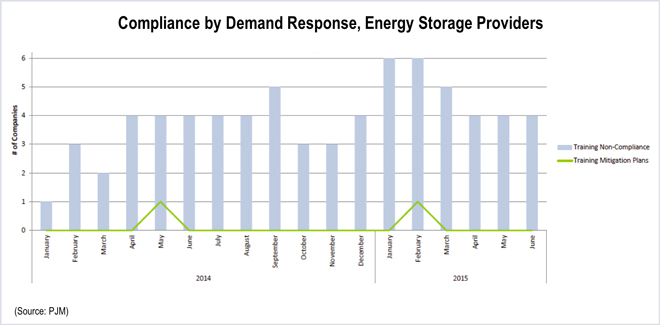PJM told the Operating Committee last week it plans to poll members on whether to expand the winter preparedness testing it began last year. The testing was credited with improving generator performance during the winter of 2014/15, but it came at a cost of about $7 million to load.
Susan Bruce, of the PJM Industrial Customer Coalition, said her members had questions about whether the testing “is a good use of ratepayer dollars.”
“It’s not a slam dunk to us that this should be expanded,” she added.
Gregory Carmean, executive director of the Organization of PJM States, which represents state regulators, suggested generators — not load — should be shouldering the costs. “What’s the rationale for load paying these costs in a Capacity Performance world?” he asked.
However, Brock Ondayko of American Electric Power noted that the coming 2015/16 winter will not be subject to the Capacity Performance rules, which don’t take effect until delivery year 2016/17.
Dan Griffiths, executive director of the Consumer Advocates of PJM States, was more sympathetic to continuing the testing, calling it a “pragmatic question.” But he requested time to poll his members before voting.
“If it’s useful for identifying problems it should be done,” he said.
Members will be asked to vote on four options, which would be reflected in Section 7.5 of Manual I4D:
- Status quo with minor red-lined changes.
- Option 1, with the addition that the program would end after winter 2015/16 for CP resources.
- Option 1, plus the following changes: Expand the exercise period from the month of December to the months of November through January; expand the maximum temperature for the testing to 40 degrees Fahrenheit in PJM’s southern zones (from 35 F); allow testing of more than 1,000 MW/day.
- Option 3, with the program terminating after winter 2015/16 for CP resources.
In a survey in June, all but three of 119 respondents said they supported continuing the testing; 93 (78%) said they preferred maintaining the current rules while 26 (22%) favored making some changes, which were not specified. (See Why Did PJM Grid Fare Better This Winter?)
PJM Seeking to Tighten Training, Certification Rules
PJM will seek OC approval next month on an initiative to improve compliance with the RTO’s training and certification requirements.
The requirements cover transmission owners, generation dispatchers, demand response providers and energy storage device operators. While transmission owners are usually in compliance, PJM said in a problem statement, non-compliance by some in the other groups “has been continuing for many months and in many cases has increased or become chronic in nature.”
Although those not in compliance are required to submit mitigation plans, most have not done so or have failed to comply with them.
In June, nine generating companies, five small generators (>75 MW) and four DR and storage providers were out of compliance with training or certification requirements. Aside from seven of the generators, none had submitted mitigation plans.
PJM said the problem could lead to operational or reliability problems as some members are unaware of their responsibilities for providing instantaneous reserves and other generator data.
Glen Boyle, manager of system operator training, said the RTO hopes to complete the work, which it is recommending be conducted by the System Operations Subcommittee, within three months. “We’ve talked internally and have some options” for solutions, he said.
PJM said it will not consider changing the existing training and certification requirements within the scope of the problem statement.
Disconnect Between PJM, Members on Meter Accuracy
A proposed update of Manual 1: Control Center Requirements has exposed a gap between PJM and some transmission owners regarding accuracy requirements for system control and monitoring meters.
As a result — at PJM’s request — members last week endorsed changes to the manual except for Section 5.
“We need more time” before changing Section 5, PJM’s Ryan Nice told the OC. “PJM needs a better overall picture of the accuracy of metering data.”
While the manual requires accuracy of ± 2% for meters supplying data to PJM’s energy management system (EMS), it’s not clear that all meters are covered by that requirement. Some TOs have meters that are only accurate to within 3%, Nice said.
The gap affects real-time meters, not billing meters.
“We need to evaluate the cost” of requiring all meters to comply with the 2% requirement, Nice said, “to make sure the operational value justifies the cost and time to members.”
— Rich Heidorn Jr.



